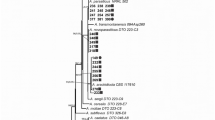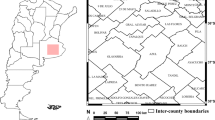Abstract
A study has been carried out in Argentina on samples of corn genotypes from a breeding station as well as in commercially available corn meal. All samples were analyzed for fungal infection and aflatoxin B1.Mycological analysis of corn genotypes showed the presence of three principal genera of filamentous fungi Fusarium (100%), Penicillium (67%) and Aspergillus (60%). In the genus Fusarium three species were identified, F. moniliforme (42%), F. nygamai (56%) andF. proliferatum (1.8%). Eight species ofPenicillium were identified, the predominant species isolated were P. minioluteum, P. funiculosum and P. variabile. In the genus ranked third in isolation frequency, two species were identified, A. flavus and A. parasiticus, the percentage of infection was 78% and 21%, respectively. Only one corn genotype was contaminated with aflatoxin B1 at a level of 5 ppb. The cornmeal samples showed great differences in fungal contamination, the values ranging from 1 × 101 to 7 × 105 cfu g−1. Fusarium (68%), Aspergillus (35%) and Penicillium (21%) were the most frequent genera isolated. Among the genus, Aspergillus, A. parasiticus (38%) was the most frequent species isolated. All the samples of corn meal were negative to aflatoxin B1. These results indicate a low degree of human exposure to aflatoxins in Argentina through the ingestion of maize or corn meal.
Similar content being viewed by others
References
Cotty PJ. Influence of field application of an atoxicogenic strain of Aspergillus flavus on the population of A. flavus infecting cotton bolls and on the aflatoxin content of cottonseed. Phytopathology 1994b; 84: 1270–1277.
International Agency for Research on Cancer (IARC). Monograph on the Evaluation of Carcinogenic Risk to Human, Vol. 56, Lyon, France, 1993: 257–263.
Chulze S, Bertinetti C, Dalcero A, Etcheverry M, Farnochi C, Torres A, Rizzo I, Varsavsky E. Incidence of aflatoxin, zearalenone and deoxynivalenol on corn in Argentina. Mycotoxin Research, 1989; 5: 9–12.
Resnik S, Neira S, Pacin A, Martinez E, Apro N, Latreite S. A survey of the natural occurrence of aflatoxins and zearalenone in Argentine field maize:1983-1994. Food Add. Contam 1996; 13: 115–120.
Torres A, Ramirez ML, Reynoso M, Rodriguez M, Chulze, S. Natural co-occurrence of Fusarium species (section Liseola) and Aspergillus flavus group species, fumonisin and aflatoxin in Argentinian corn. Cereal Research Communications 1997; 389–391.
Pitt JI, Hocking, AD (eds). Fungi and Food Spoilage. Sydney Academic Press, Australia, 1997.
Raper KB, Fennell DI. The genus Aspergillus. The Williams and Wilkins Co., Baltimore, 1965.
Klich MA, Pitt JI. A Laboratory Guide to Common Aspergillus Species and Their Teleomorphs. Commonwealth Scientific and Industrial Research, 1994.
Pitt JI. A laboratory guide to common Penicillium species. CSIRO, División of Food Research Sydney. Academic Press, Australia, 1988.
Nelson PE, Toussoun TA, Marasas WFO. Fusarium Species: An Illustrated Manual for Identification. University Park, The Pennsylvania State University Press, 1983.
Samson RA, Hoekstra SE, van Oorschot AN. Introduction to Food/Borne Fungi. Centraal Bureau voor Schimmel Cultures, 1981.
Trucksess MW, Stack ME, Nesheim S, Albert RH, Romer TR. Multifunctional column coupled with liquid chromatography for determination of aflatoxin B1, B2, G1, and G2 in corn, almonds, Brasil nuts, peanuts, and pistachio nuts: Collaborative study. J AOAC Internat 1994; 77: 1512–1521.
Gonzalez HLL. Estudios de la distribución de la micoflora contaminante de maíz recién cosechado. Riesgo potencial de aparición de micotoxinas en la Región Maicera Argentina. Tesis de Doctorado de la Universidad Nacional de Buenos Aires, Argentina.
Pozzi CR, Correa B, Gambale W, Paula CR, Chacon Reche NO, Meirelles MCA. Postharvest and stored corn in Brazil: mycoflora interaction, abiotic factors and mycotoxin occurrence. Food Additives and Contaminants 1995; 12: 313–319.
Garbini A, Galli S, Tomchinsky E, Delli Santi V, Gandía S, Rizzo J, Varsavsky E, Frade H. Aflatoxinas: control en alimentos a base de harina de maíz. Presentado al 2nd Congreso Latinoamericano de Micotoxicología, 14 al 18 de Julio de 1987, Maracay, Venezuela. En Libro de resúmenes: 86–87.
Bullerman LL B and Tsai W J. Incidence and Levels of Fusarium moniliforme, Fusarium proliferatum and fumonisins in corn and corn-based foods. Journal of Food Protection 1994; 57: 541–546.
Chulze SN, Ramirez ML, Farnochi MC, Pascale M, Visconti A, March G. Fusarium and fumonisins occurrence in Argentinian corn at different ear maturity stages J Agric Food Chem 1996; 44: 2797–2801.
Ramírez ML, Pascale M, Chulze S, Reynoso MM, Visconti A. Natural occurrence of fumonisins associated to Fusarium contamination in commercial corn hybrids grown in Argentina. Mycopathologia.1996; 135: 29–34.
Farnochi MC, Etcheverry M, Dalcero A, Chulze S. Fusarium species (section Liseola) and fumonisins in storage corn from Argentina. Cereal Research Communications. 1997; 25: 587–589.
Wicklow DT, Horn BW, Shotwell OL, Hesseltine CW, Caldwell RW. Fungal interference with Aspergillus flavus infection and aflatoxin contamination of maize, grown in a controlled environment. Phytopathology 1988; 78: 68–74.
Zummo N, Scott GE. Relative aggressiveness of Aspergillus flavus and Aspergillus parasiticus in maize in Mississippi. Plant Dis 1990; 74: 978–981.
Zummo N and Scott GE. Interaction of Fusarium moniliforme and Aspergillus flavus on kernel infection and aflatoxin contamination in maize ears. Plant Dis 1992; 76: 771–773.
Codigo Alimentario Argentino (C.A.A.), Canal. Asoc. S.R.L. Art 156 bis, Buenos Aires, 1992: 24.
Food and Agriculture Organization of the United Nations (FAO). Worldwide regulations for mycotoxins in 1995. A compendium 1997; 64: 7–28.
Author information
Authors and Affiliations
Rights and permissions
About this article
Cite this article
Etcheverry, M., Nesci, A., Barros, G. et al. Occurrence of Aspergillus section Flavi and aflatoxin B1 in corn genotypes and corn meal in Argentina. Mycopathologia 147, 37–41 (1999). https://doi.org/10.1023/A:1007040123181
Issue Date:
DOI: https://doi.org/10.1023/A:1007040123181




